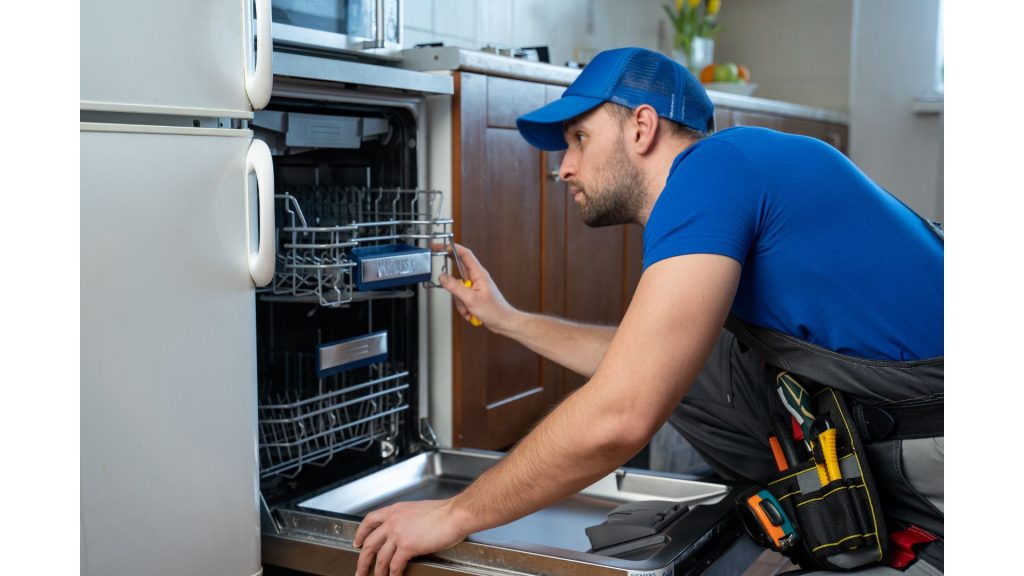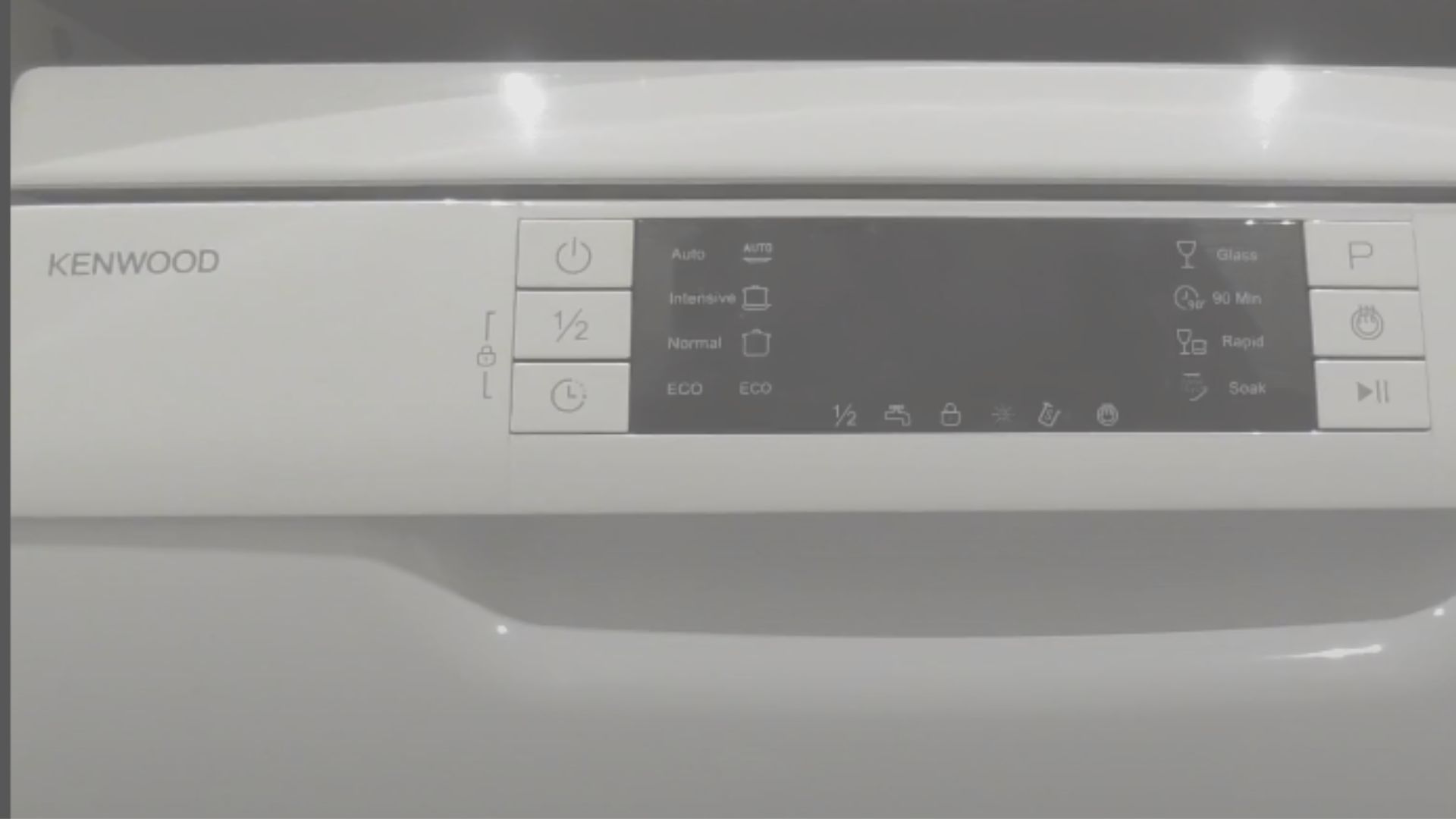Kenwood dishwashers can generate strange sounds for one or more of the following reasons:
1). Water is Noisy
Water is not quiet. You will hear it hiss and gurgle as it flows through the water line to enter the dishwasher. You may also hear it as it drains out of the machine. The drainage process is more likely to distract you with its noise because it relies on the drain pump, and the drain pump is susceptible to various faults and defects.
If you hear buzzing or grinding, and the water refuses to drain (or drains slowly), the drain pump has a problem. Unfortunately, troubleshooting the pump means opening the dishwasher, a task many laypeople cannot undertake.
This means hiring a technician. But you can’t avoid this outcome. A Kenwood dishwasher that doesn’t drain won’t work.
2). The Chopper Blade Has Debris
Experts will encourage you to clear the plates, pots, and pans before adding them to the dishwasher. But if you forget, the Kenwood appliance has a blade that cuts solid debris into smaller pieces that can safely exit the dishwasher through the drain.
Expect a much louder noise than usual once the blade encounters hard objects. Those objects can obstruct the blade’s movements permanently. The noise will not only persist but also grow louder.
3). The Bearings Have Gone Bad
Dishwashers have several moving parts. Those parts use bearings. That includes the chopper blade. Experts will lubricate these bearings during maintenance to protect them from the wear and tear they typically accumulate because of friction.
But proper maintenance will only slow the rate of wear and tear. Eventually, the bearings will fail. Once that happens, expect a lot of grinding, buzzing, and squealing. The severity of the noise depends on the extent of the damage.
4). The Dishwasher Is Knocking Against Nearby Objects
Dishwashers vibrate. They don’t shake as much as washing machines. But their operations generate some motion. Those vibrations can grow because of the water flowing through the line at high pressure or defects such as worn-out bearings.
The vibrations tend to go unnoticed unless the floor is uneven or the Kenwood appliance has objects in the vicinity it can knock against.
5). The Dishes Are Poorly Stacked
Have you read the manual? Do you know why it shows you how to stack the dishes? Because stacking them poorly can interfere with the dishwasher’s work. The dishes will knock against one another or restrict the movements of the spray arms. Similar issues can occur because you overloaded the dishwasher.
6). The Pump Is Blocked
The pump intake prevents clogging by catching food particles. However, the pump intake can clog after encountering large food particles in significant quantities or hard objects like plastic and glass shards.
Just Answer wants you to check the pump chamber and impeller for debris. But unless you’re ready to access the drain pump, you should leave this task to an expert. They can check the drain pump, drain valve solenoid, and impeller for defects.
7). The Kenwood Dishwasher Has A Defective Spray Arm
The spray arms should spin freely. People usually blame obstructions when the spray arms malfunction. However, these components can corrode because of scaling from hard water.
8). The Water Is Knocking
The water may knock against the lines because the valve closes suddenly. This so-called water hammer is normal. It should only worry you if a plumber installs a water hammer arrestor, but the noise persists. This means something else is wrong.
9). The Motor Has Failed
A defective dishwasher motor tends to generate a rattling sound. Test this theory by running an empty wash cycle and listening for rattling from the motor. You should first rule out clogging before you blame the motor.
10). The Inlet Valve Is Defective
The inlet valve controls the water flow. A faulty valve can limit the dishwasher’s access to water. It can also lower the pressure. Experts associate faulty valves with screeching, hissing, and buzzing.
Different Kenwood Dishwasher Noise And Troubleshooting Tips

Kenwood Dishwasher Grinding Noise
- The chopper blade can make grinding noises when it encounters hard objects. The chopper blade is designed to cut large but soft debris.
- The pump has obstructions. This could be foreign objects or hard food items.
- The inlet valve is clogged. This will either reduce the pressure or prevent the water from entering the Kenwood dishwasher. Both outcomes will interfere with the dishwasher’s work.
- The wash motor is defective.
- The filter is blocked.
- You have a clogged drain.
- Damaged circulation pump and motor bearings.
- If the dishwasher has an inbuilt garbage disposal, the garbage disposal is making a grinding noise.
How To Fix It?
- Remove the debris obstructing the chopper blade. The process Flamingo Appliance Service has described involves removing the dish rack and spray arms to reach the chopper blade. If you’re not ready to take the dishwasher apart like this, hire an expert.
- If the chopper blade is worn-out or the bearings are defective, replace them.
- Unclog the pump.
- Unclog the valve.
- Replace a defective wash motor.
- Check the drain system for blockages. If you can’t see physical obstructions, check the hose for kinks. Whether you remove the kinks or replace the hose depends on the severity of the problem. You can’t fix serious kinks. The hose will eventually fall apart.
- Check the motor bearings for wear and tear, and replace them where necessary.
- Inspect the circulation pump motor bearings. They can also wear out. Replace them.
- Check the garbage disposal for obstructions and remove whatever debris you find.
Kenwood Dishwasher Humming Noise
- If you hear the humming during the drying cycle, the fan is running
- Something is lodged in the drain pump, or the drain pump is faulty. Experts reach this conclusion if they notice the humming during the drain cycle.
- The motor pump makes a gentle hum. This is normal. You don’t have to fix it. However, a defective motor is louder than usual.
How To Fix It?
- If the ventilation fan is louder than usual, inspect it. Do you see obstructions? Remove them. Have you noticed loose connections? Is the fan defective? You should consider replacing it.
- Replace a defective wash motor. A technician can analyze the component to determine whether the fault lies with the motor or the capacitor. Technicians have multimeters with microfarad settings that scrutinize such issues. Replacing the capacitor may resolve the issue.
- Access the drain pump and check for debris. Remove whatever you find. You should also look for obstructions in the hose and the vent that takes the dirty water from the Kenwood dishwasher.
- Replace a damaged drain pump.
Kenwood Dishwasher Making Buzzing Noise
- Buzzing is normal for many dishwashers. They tend to buzz or hum. You need an expert to determine whether the buzzing you hear is louder than it should be. If you’ve had the Kenwood dishwasher for a while, compare the buzzing now to what it was before.
- The fan is wearing out. Therefore, it will make a louder hum or buzz than usual. The same thing will happen to the food disposer and drain pump.
- The impeller is blocked or stalled.
- The wash pump is broken.
- The drain pump is defective.
How To Fix It?
- If the dishwasher is older than ten years and still works, but it’s louder than usual, get a replacement. The appliance is buzzing because the moving parts are worn out. You can replace them all, but getting a new Kenwood dishwasher is more cost-effective.
- Inspect the impeller for damage. Whether you should repair or replace it depends on the severity of the damage. If you’re lucky, the impeller is blocked. Removing the blockages will stop the buzzing noise.
- Check the drain pump for blockages. If you can find the obstructions, remove them. If the pump is clean, consider replacing it. If the Kenwood appliance won’t drain, the pump motor is probably dead. Use a multimeter to test it for continuity. If the motor fails the test, you need a new drain pump. Ultimately, people don’t repair drain pumps.
- Clean the drain valve. If it has a defect, replace it.
- Check the drain hose for clogging and clean it if you see obstructions.
- Replace a broken wash pump.
- Fix or replace a damaged fan.

